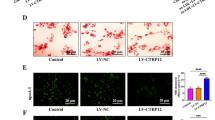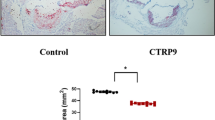Abstract
C1q tumor necrosis factor–related protein 15 (CTRP15), a newly identified myokine, is closely implicated in cardiovascular disease. However, the role of CTRP15 in atherosclerosis is still unclear. This study aims to determine the role of CTRP15 in atherosclerosis and explore the underlying mechanisms. Our findings revealed that lentivirus-mediated CTRP15 overexpression significantly decreased atherosclerotic plaque lesions and increased reverse cholesterol transport (RCT) efficiency and circulating HDL-C levels in apolipoprotein E-deficient (apoE−/−) mice. Consistently, in vitro, overexpression of CTRP15 also inhibited intracellular lipid accumulation and promoted cholesterol efflux from macrophages. Mechanistically, CTRP15 decreased the expression of miR-101-3p by upregulating T-cadherin, thereby facilitating ABCA1 expression and cholesterol efflux. In summary, these data indicate that CTRP15 inhibits the development of atherosclerosis by enhancing RCT efficiency and increasing plasma HDL-C levels via the T-cadherin/miR-101-3p/ABCA1 pathway. Targeting CTRP15 may serve as a novel and promising therapeutic strategy for atherosclerotic cardiovascular diseases.







Similar content being viewed by others
Abbreviations
- CTRP15:
-
C1q tumor necrosis factor-related protein 15
- ApoE−/− :
-
Apolipoprotein E-deficient
- CAD:
-
Coronary artery disease
- PBS:
-
Phosphate-buffered saline
- ApoA-I:
-
Apolipoprotein A-I
- LV-NC:
-
Lentiviral empty vector
- HDL:
-
High-density lipoprotein
- TGFβ1:
-
Transforming growth factor-β1
- TNF-α:
-
Tumor necrosis factor alpha
- OCT:
-
Optimal cutting temperature
- LDL-C:
-
LDL cholesterol
- AdipoR1:
-
Adiponectin receptor 1
- RCT:
-
Reverse cholesterol transport
- PBS:
-
Phosphate-buffered saline
- MPMs:
-
Mouse peritoneal macrophages
- H&E:
-
Hematoxylin and eosin
- ABCA1:
-
ATP-binding cassette transporter A1
- TG:
-
Triglyceride
- miRNAs:
-
MicroRNAs
- TC:
-
Total cholesterol
- IL-6:
-
Interleukin-6
- HDL-C:
-
HDL-cholesterol
- ac-LDL:
-
Acetylated-LDL
- HPLC:
-
High-performance liquid chromatography
References
Adorni MP, Zimetti F, Billheimer JT, Wang N, Rader DJ, Phillips MC, Rothblat GH (2007) The roles of different pathways in the release of cholesterol from macrophages. J Lipid Res 48(11):2453–2462. https://doi.org/10.1194/jlr.M700274-JLR200
Ahmadi R, Fadaei R, Shokoohi Nahrkhalaji A, Panahi G, Fallah S (2021) The impacts of C1q/TNF-related protein-15 and adiponectin on Interleukin-6 and tumor necrosis factor-α in primary macrophages of patients with coronary artery diseases. Cytokine 142:155470. https://doi.org/10.1016/j.cyto.2021.155470
Brodersen P, Voinnet O (2009) Revisiting the principles of microRNA target recognition and mode of action. Nat Rev Mol Cell Biol 10(2):141–148. https://doi.org/10.1038/nrm2619
Cai Y, Liu J, Cai SK, Miao EY, Jia CQ, Fan YZ, Li YB (2020) Eicosapentaenoic acid’s metabolism of 15-LOX-1 promotes the expression of miR-101 thus inhibits Cox2 pathway in colon cancer. Onco Targets Ther 13:5605–5616. https://doi.org/10.2147/ott.S237562
Cao S, Li L, Geng X, Ma Y, Huang X, Kang X (2019) The upregulation of miR-101 promotes vascular endothelial cell apoptosis and suppresses cell migration in acute coronary syndrome by targeting CDH5. Int J Clin Exp Pathol 12(9):3320–3328
Castaño C, Kalko S, Novials A, Párrizas M (2018) Obesity-associated exosomal miRNAs modulate glucose and lipid metabolism in mice. Proc Natl Acad Sci U S A 115(48):12158–12163. https://doi.org/10.1073/pnas.1808855115
Chen Q, Li X, Kong L, Xu Q, Wang Z, Lv Q (2020) miR-101-3p induces vascular endothelial cell dysfunction by targeting tet methylcytosine dioxygenase 2. Acta Biochim Biophys Sin (Shanghai) 52(2):180–191. https://doi.org/10.1093/abbs/gmz154
de Villiers WJ, Smart EJ (1999) Macrophage scavenger receptors and foam cell formation. J Leukoc Biol 66(5):740–746. https://doi.org/10.1002/jlb.66.5.740
Denzel MS, Scimia MC, Zumstein PM, Walsh K, Ruiz-Lozano P, Ranscht B (2010) T-cadherin is critical for adiponectin-mediated cardioprotection in mice. J Clin Invest 120(12):4342–4352. https://doi.org/10.1172/jci43464
Fujishima Y, Maeda N, Matsuda K, Masuda S, Mori T, Fukuda S, …, Shimomura I (2017) Adiponectin association with T-cadherin protects against neointima proliferation and atherosclerosis. Faseb J 31(4):1571-1583.https://doi.org/10.1096/fj.201601064R
Gelissen IC, Harris M, Rye KA, Quinn C, Brown AJ, Kockx M, …, Jessup W (2006) ABCA1 and ABCG1 synergize to mediate cholesterol export to apoA-I. Arterioscler Thromb Vasc Biol 26(3):534-540.https://doi.org/10.1161/01.ATV.0000200082.58536.e1
Gordon DJ, Probstfield JL, Garrison RJ, Neaton JD, Castelli WP, Knoke JD, …, Tyroler HA (1989) High-density lipoprotein cholesterol and cardiovascular disease. Four prospective American studies. Circulation 79(1):8-15.https://doi.org/10.1161/01.cir.79.1.8
Huntzinger E, Izaurralde E (2011) Gene silencing by microRNAs: contributions of translational repression and mRNA decay. Nat Rev Genet 12(2):99–110. https://doi.org/10.1038/nrg2936
Iwabu M, Okada-Iwabu M, Yamauchi T, Kadowaki T (2015) Adiponectin/adiponectin receptor in disease and aging. NPJ Aging Mech Dis 1:15013. https://doi.org/10.1038/npjamd.2015.13
Katsanidis E, Addis PB (1999) Novel HPLC analysis of tocopherols, tocotrienols, and cholesterol in tissue. Free Radic Biol Med 27(11–12):1137–1140. https://doi.org/10.1016/s0891-5849(99)00205-1
Lake NJ, Taylor RL, Trahair H, Harikrishnan KN, Curran JE, Almeida M, …, Bozaoglu K (2017) TRAK2, a novel regulator of ABCA1 expression, cholesterol efflux and HDL biogenesis. Eur Heart J 38(48):3579-3587.https://doi.org/10.1093/eurheartj/ehx315
Li H, Yu XH, Ou X, Ouyang XP, Tang CK (2021) Hepatic cholesterol transport and its role in non-alcoholic fatty liver disease and atherosclerosis. Prog Lipid Res 83:101109. https://doi.org/10.1016/j.plipres.2021.101109
Li J, Li Y, Wang Y, He X, Wang J, Cai W, …, Hu D (2021) Overexpression of miR-101 suppresses collagen synthesis by targeting EZH2 in hypertrophic scar fibroblasts. Burns Trauma 9:tkab038. https://doi.org/10.1093/burnst/tkab038
Li K, Liao X, Wang K, Mi Q, Zhang T, Jia Y, …, Yang G (2018). Myonectin predicts the development of type 2 diabetes. J Clin Endocrinol Metab 103(1):139-147.https://doi.org/10.1210/jc.2017-01604
Liu P, Ye F, Xie X, Li X, Tang H, Li S, …, Xie X (2016) mir-101-3p is a key regulator of tumor metabolism in triple negative breast cancer targeting AMPK. Oncotarget 7(23):35188-35198.https://doi.org/10.18632/oncotarget.9072
Liu Y, Zhong Y, Chen H, Wang D, Wang M, Ou JS, Xia M (2017) Retinol-binding protein-dependent cholesterol uptake regulates macrophage foam cell formation and promotes atherosclerosis. Circulation 135(14):1339–1354. https://doi.org/10.1161/circulationaha.116.024503
Nishimoto H, Yamamoto A, Furukawa S, Wakisaka S, Maeda T (2017) C1q/TNF-related protein 3 expression and effects on adipocyte differentiation of 3T3-L1 cells. Cell Biol Int 41(2):197–203. https://doi.org/10.1002/cbin.10674
Ohashi R, Mu H, Wang X, Yao Q, Chen C (2005) Reverse cholesterol transport and cholesterol efflux in atherosclerosis. QJM 98(12):845–856. https://doi.org/10.1093/qjmed/hci136
Otaka N, Shibata R, Ohashi K, Uemura Y, Kambara T, Enomoto T, …, Ouchi N (2018) Myonectin is an exercise-induced myokine that protects the heart from ischemia-reperfusion injury. Circ Res 123(12):1326-1338.https://doi.org/10.1161/circresaha.118.313777
Ou X, Gao JH, He LH, Yu XH, Wang G, Zou J, …, Tang CK (2020) Angiopoietin-1 aggravates atherosclerosis by inhibiting cholesterol efflux and promoting inflammatory response. Biochim Biophys Acta Mol Cell Biol Lipids 1865(2):158535.https://doi.org/10.1016/j.bbalip.2019.158535
Park TJ, Park A, Kim J, Kim JY, Han BS, Oh KJ, …, Kim WK (2021) Myonectin inhibits adipogenesis in 3T3-L1 preadipocytes by regulating p38 MAPK pathway. BMB Rep 54(2):124-129.https://doi.org/10.5483/BMBRep.2021.54.2.262
Schäffler A, Buechler C (2012) CTRP family: linking immunity to metabolism. Trends Endocrinol Metab 23(94):194–204. https://doi.org/10.1016/j.tem.2011.12.003
Schäffler A, Schölmerich J, Salzberger B (2007) Adipose tissue as an immunological organ: Toll-like receptors, C1q/TNFs and CTRPs. Trends Immunol 28(9):393–399. https://doi.org/10.1016/j.it.2007.07.003
Seldin MM, Peterson JM, Byerly MS, Wei Z, Wong GW (2012) Myonectin (CTRP15), a novel myokine that links skeletal muscle to systemic lipid homeostasis. J Biol Chem 287(15):11968–11980. https://doi.org/10.1074/jbc.M111.336834
Seldin MM, Tan SY, Wong GW (2014) Metabolic function of the CTRP family of hormones. Rev Endocr Metab Disord 15(2):111–123. https://doi.org/10.1007/s11154-013-9255-7
Shokoohi Nahrkhalaji A, Ahmadi R, Fadaei R, Panahi G, Razzaghi M, Fallah S (2019) Higher serum level of CTRP15 in patients with coronary artery disease is associated with disease severity, body mass index and insulin resistance. Arch Physiol Biochem:1-5.https://doi.org/10.1080/13813455.2019.1675713
Si Y, Fan W, Sun L (2020) A review of the relationship between CTRP family and coronary artery disease. Curr Atheroscler Rep 22(6):22. https://doi.org/10.1007/s11883-020-00840-0
Wang M, Wang D, Zhang Y, Wang X, Liu Y, Xia M (2013) Adiponectin increases macrophages cholesterol efflux and suppresses foam cell formation in patients with type 2 diabetes mellitus. Atherosclerosis 229(1):62–70. https://doi.org/10.1016/j.atherosclerosis.2013.01.017
Weber C, Noels H (2011) Atherosclerosis: current pathogenesis and therapeutic options. Nat Med 17(11):1410–1422. https://doi.org/10.1038/nm.2538
Xin Y, Tang L, Chen J, Chen D, Wen W, Han F (2021) Inhibition of miR-101-3p protects against sepsis-induced myocardial injury by inhibiting MAPK and NF‑κB pathway activation via the upregulation of DUSP1. Int J Mol Med 47(3).https://doi.org/10.3892/ijmm.2021.4853
Yang Z, Cappello T, Wang L (2015) Emerging role of microRNAs in lipid metabolism. Acta Pharm Sin B 5(2):145–150. https://doi.org/10.1016/j.apsb.2015.01.002
Zhang Y, Liu C, Liu J, Guo R, Yan Z, Liu W, …, Wang Y (2020). Implications of C1q/TNF-related protein superfamily in patients with coronary artery disease. Sci Rep 10(1):878.https://doi.org/10.1038/s41598-020-57877-z
Zhao Q, Zhang CL, Xiang RL, Wu LL, Li L (2020) CTRP15 derived from cardiac myocytes attenuates TGFβ1-induced fibrotic response in cardiac fibroblasts. Cardiovasc Drugs Ther 34(5):591–604. https://doi.org/10.1007/s10557-020-06970-6
Funding
This study was supported by the Hunan Natural Science Fund-Youth Foundation Project (No. 2021JJ40500) and the Scientific Research Project of the Hunan Health Commission (No. 20200410).
Author information
Authors and Affiliations
Contributions
Zhi-Lu Sun conceived and designed the experiments. Wei-Hua Tan, Zheng-Liang Peng, and Ting You performed the experiments. Wei-Hua Tan drafted and wrote the manuscript. Zheng-Liang Peng and Ting You analyzed the data. Zhi-Lu Sun provided materials and reagents. Final approval of manuscript: all authors. The authors declare that all data were generated in-house and that no paper mill was used.
Corresponding author
Ethics declarations
Ethics approval
This study was approved by the Animal Ethics Committee of the University of South China.
Conflict of interest
The authors declare no competing interests.
Research involving human participants and/or animals
Animals.
Additional information
Publisher's note
Springer Nature remains neutral with regard to jurisdictional claims in published maps and institutional affiliations.
Key points
1. CTRP15 inhibits atherosclerosis by promoting RCT and macrophage cholesterol efflux in apoE−/− mice.
2. CTRP15 upregulates ABCA1 expression and cholesterol efflux through downregulating the expression of miR-101-3p.
3. T-cadherin is required for the effect of CTRP15 on ABCA1 expression.
Supplementary Information
Below is the link to the electronic supplementary material.
Rights and permissions
About this article
Cite this article
Tan, WH., Peng, ZL., You, T. et al. CTRP15 promotes macrophage cholesterol efflux and attenuates atherosclerosis by increasing the expression of ABCA1. J Physiol Biochem 78, 653–666 (2022). https://doi.org/10.1007/s13105-022-00885-6
Received:
Accepted:
Published:
Issue Date:
DOI: https://doi.org/10.1007/s13105-022-00885-6




